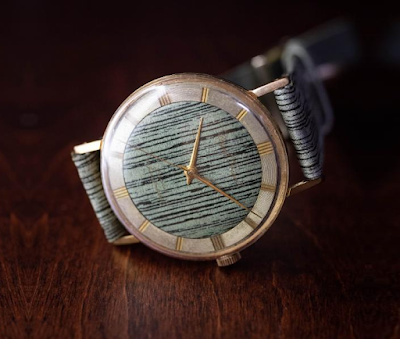Exactly
one year ago, I dedicated a blog post to some
unusual Royal Orients from the 1950s, in praise of their distinct (and
sometimes truly outlandish) designs. Since then, I came across more special
Royal Orients of the same era that appear worthy of posting here – all of which are from recent sale ads! Let's take a look…
This
model should be familiar to those of you who watched closely the photo at the
top of last year's blog post. It is similar in concept to my polka-dot
Royal Orient, having that uniquely textured dial – and here, attached to
the original matching leather strap. I find this combination absolutely wonderful.
What
is even more amazing, is this – a third design from the same family of dial and
strap combinations that did not appear in the Orient Catalog Book!
Again,
it features the unusually organic dial texture. What is more surprising, I
actually found two samples of this design – and as you can see in the
comparison below, the patterns are not identical! No two watches are the same, adding to the rarity and prestige of this piece.
A little
more conservative in their use of materials, but certainly quite uncommon in
their dial design, are these two versions. Definitely not intended for people
who like a clean dial… still, quite nice aren't they.
If
you're looking for something cleaner, here are two nice examples. The top one
is gold-filled, like most Royal Orient at the time. I like the way the gold
markers and outer ring complement each other – the whole thing really looks
like proper jewelry.
The
watch below is similarly clean but in steel (or perhaps silver, by the looks of
it). The concept is the same, the dial even more simple at first sight, but
again it's that textured outer ring that makes the thing look special, and far from
plain.
Looking
for a Royal Orient that's clean but still, quite different from the rest of the crop? Well, look no further than this beauty!
I
actually found two variants of this lugless design, one having the usual stick
markers, but the one I liked most has these lovely Arabic number fonts (that
remind me in particular of the Glashütte Sixties watches). Note that this is a
slightly smaller watch, measuring 34mm in diameter, compared to 35mm of most
other Royal Orients featured here.
I'll
wrap up this lot of Royals with the nice little couple below… a rare bunch
having a numeral at 12 instead of the stick markers. However, note that one has
the Arabic number while the other has the Roman XII.
Pictures
that appear on this post were taken from Yokohama's "Fire Kids" online
shop, and various other sale ads.

















